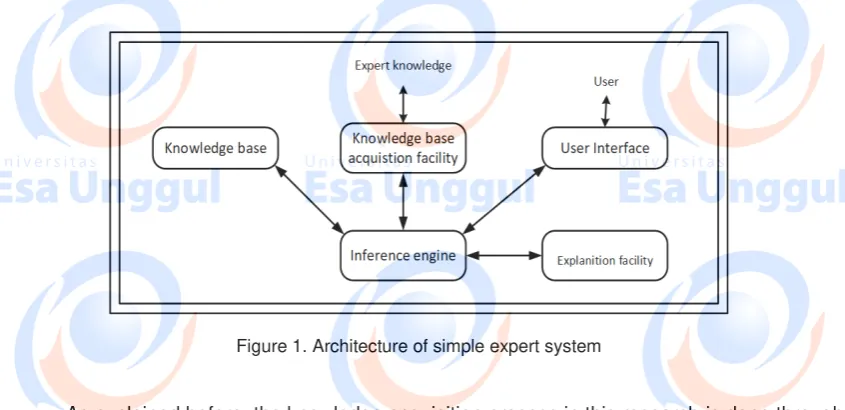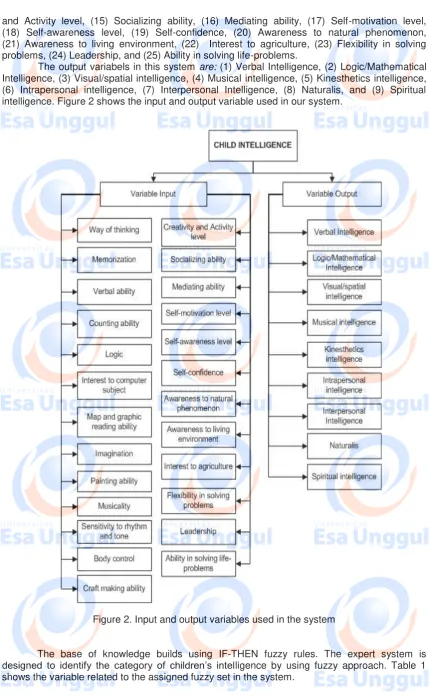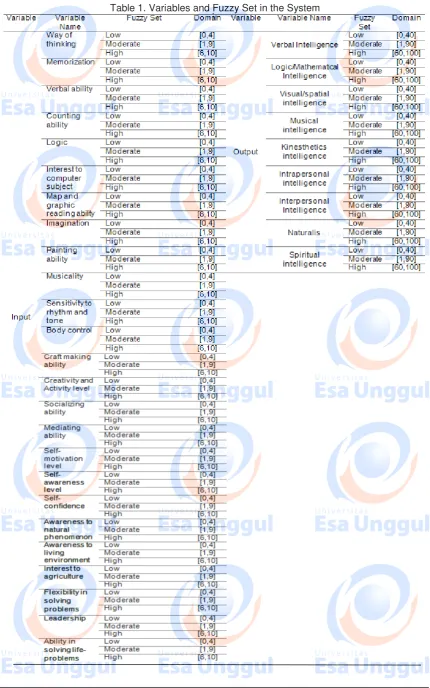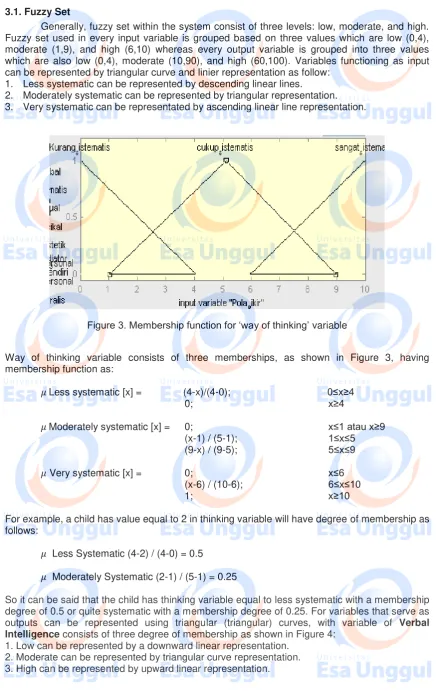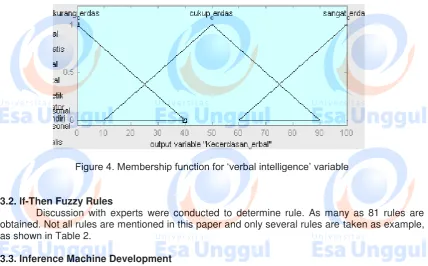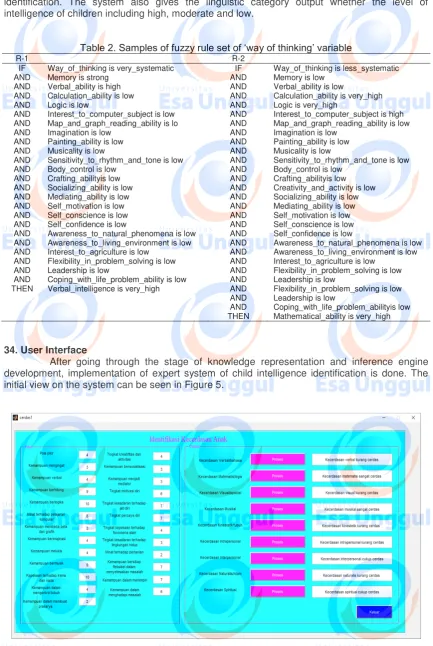DOI: 10.12928/TELKOMNIKA.v16i4.7779 1688
Designing Fuzzy Expert System to Identify Child
Intelligence
Muhamad Bahrul Ulum*1, Vitri Tundjungsari2 1
Informatics Engineering Program Esa Unggul University, Jakarta, Indonesia 2Information Technology Faculty YARSI University, Jakarta, Indonesia
*Corresponding author, e-mail: [email protected], [email protected]
Abstract
Every child is special and has her/his own unique potential. Identifying child’s potential in early
age is important for teaching purpose since every child has difference intelligence and interest. Therefore
children’s teaching and learning process should be delivered based on child’s interest and intelligence, instead of forcing children to excel in every subject. We propose our research to identify child’s intelligence
by designing fuzzy expert system. The system works based on several input data of children’s multiple
intelligences. The fuzzy expert system is developed using 25 input variables and resulted in 9 output variables. The system classifies the result based on 9 types of intelligence in human, where each exhibits different level. We produce 81 rules with fuzzy set of three different levels value (high, moderate, or low) for every kind of intelligence. The result of this research is very useful to help parents and teachers for
determining their method of teaching based on children’s potential.
Keywords: Fuzzy, Child intelligence, Expert system
Copyright © 2018 Universitas Ahmad Dahlan. All rights reserved.
1. Introduction
Identifying children‟s potential in early age is required to teach children based on their intelligence and interest, instead of forcing children to learn based on parents‟ and teachers‟ instructions. School curriculum tends to develop only two intelligences, which are logical-mathematical intelligence and linguistic/verbal intelligence. This fact causes children who are not good in those two aspects, categorized as stupid or less intelligent, while in reality they may have been more intelligent in other fields. The importance of teaching children according to their intelligence has been repeatedly stated by psychologist, however the problem lies in how every parent or children to identify which intelligence is in their children or students.
Many children are no longer interested in exact science such as Mathematics, Physics, and Chemistry. For these children, such subjects are harder to be understood, while these subjects are included in main curriculum or main competence which must be mastered by middle school to high school student. There are also many children do not realize which potential they possess even until they continue to higher education or looking for work. These children are still unable to find out their ability or intelligences. This happened because today basic formal education still not deeply explored children potential in early age. As a result, children in their adult age feel that they have chosen the wrong field in education or work.
Many children feel that their future will not be bright because their grade in sciences or mathematics is low. Such stigmas also spread around in society which causes parents to have more or less similar views. Thus, many parents are scared of the outcome and gives supplementary education for their children through private classes. In fact, such action may not be right and instead gives additional stress to children. Every child is unique and should be given different treatment depends on his or her capability and interests.
developmental disorder [1] and its design and simulation [2], whereas the fact in field show that identification of children intelligence with inexpensive fee is extremely needed. Authors in [3] develop expert system to identify children disorder under 10 years old, such as: mental retardation, autism, ADHD, and conduct disorder.
There are also several research conducted in children learning area. Authors in [4] create a tool to recognize mathematically gifted children using expert system, teachers, and psychologist estimation. Hernandez et al. [5] develop expert system to diagnose learning difficulties in children‟s basic education. Schipor et al [6] build a mobile application using knowledge base of expert system for dyslalic children therapy. The knowledge base have over 150 rules and 19 linguistic variables. Author in [7] develops e-learning model, in order to teach computer programming for secondary students. In order to solve the problem stated above, this research is performed. Our research has objective to design fuzzy expert system to identify children intelligence based on their interests and intelligence.
2. Research Method
We develop the system using expert system concept. Expert system is one of the areas of artificial intelligence, consists of knowledge and analytical skills to represent human experts in a specific problem domain [8]. In this research we create rule based expert system based on expert‟s judgment, known as knowledge acquisition. We interview 3 psychologists to transfer their knowledge to our expert system. The knowledge engineers then translate the knowledge gathered from human expert and build the knowledge base.
Author in [9] explains architecture of simple expert system, which contains of: Knowledge base, knowledge base acquisition facility, user interface, inference engine, and explanation facility. Figure 1 illustrates the architecture of simple expert system.
Figure 1. Architecture of simple expert system
As explained before, the knowledge acquisition process in this research is done through experts‟ interview. Sometimes, the expert‟s knowledge and judgment is “fuzzy”, therefore the knowledge engineer should be able to express the knowledge and represent it into mechanisms, rules, and codes. Based on the concept of expert system‟s architecture above, we employ our research method in several stages, i.e.: (1) Problem identification, (2) Base knowledge searching, (3) Knowledge acquisition, (4) Knowledge representation, (5) Inference machine development, and (6) Implementation and testing. The explanation of each stage is as follows:
2.1. Problem Identification
2.2. Base Knowledge Searching
The search for knowledge resources includes expert search activities, literature, and necessary data. The expert is someone who has expertise and knowledge in the field studied which in this case is about the intelligence of the child. The expert for this system comes from practitioners and psychology lecturers. questioner. The acquisition begins with a literature study and then compiled the core question and acquisition framework to the expert.
Acquisitions are also carried out by taking knowledge from literature sources and then confirming to experts based on the results of literature studies. Based on this acquisition process, we obtained knowledge related to the variables that affect the level/type of intelligence in children as input variables. The output variable is a type of intelligence that is owned by a child. The variables used in this study consist of 25 input variables and 9 output variables.
2.4. Knowledge Representation
Knowledge gained from the acquisition process is then represented to form a knowledge base. The knowledge base consists of the intended knowledge and the specifications of the subject matter to be resolved. The method of knowledge representation used in this system is fuzzy representation. Fuzzy representation is used because the environmental factors as inputs on this system have the nature of ambiguity and uncertainty. The integration of expert systems with fuzzy systems is known as the fuzzy expert system. The system is an expert system development that uses overall fuzzy logic, which includes the fuzzy set, the fuzzy if-then rule, and the inference process. Each characteristic variable of intelligence possessed by a child has different rules, so the total rules on this system amount to 81 rules. This rule is obtained based on knowledge acquisition process which obtained from literatures and discussions with experts.
2.5. Inference Machine Development
The inference engine is a component of an expert system that directs knowledge from the knowledge base to reach conclusion. The inference process of this system uses the Mamdani method. In this method, both antecedents and consequences are fuzzy sets. Mamdani method has advantages such as: more intuitive, more accepted by many parties, and more suitable if input is received from humans (not machines) [11]. Mamdani's fuzzy inference process is done in four steps [12]:
1. Fuzzification of input variables. At this stage the input is calculated the degree of membership to each fuzzy set.
2. Evaluation of rules
3. Output aggregation result of rule evaluation
4. Deflate the fuzzy set of outputs to a single value (crisp).
2.6. Implementation and Testing
System was developed by application to create fuzzy model. Testing is done by experts‟ examination. The purpose of this phase is to check whether the expert system built has adequately represented the human expert. Stages of activity can be repeated on the acquisition process to increase knowledge, improvement on knowledge representation, or improvement on inference machine if the system is not enough to represent human expert.
3. System modeling
and Activity level, (15) Socializing ability, (16) Mediating ability, (17) Self-motivation level, (18) Self-awareness level, (19) Self-confidence, (20) Awareness to natural phenomenon, (21) Awareness to living environment, (22) Interest to agriculture, (23) Flexibility in solving problems, (24) Leadership, and (25) Ability in solving life-problems.
The output variabels in this system are: (1) Verbal Intelligence, (2) Logic/Mathematical Intelligence, (3) Visual/spatial intelligence, (4) Musical intelligence, (5) Kinesthetics intelligence, (6) Intrapersonal intelligence, (7) Interpersonal Intelligence, (8) Naturalis, and (9) Spiritual intelligence. Figure 2 shows the input and output variable used in our system.
Figure 2. Input and output variables used in the system
3.1. Fuzzy Set
Generally, fuzzy set within the system consist of three levels: low, moderate, and high. Fuzzy set used in every input variable is grouped based on three values which are low (0,4), moderate (1,9), and high (6,10) whereas every output variable is grouped into three values which are also low (0,4), moderate (10,90), and high (60,100). Variables functioning as input can be represented by triangular curve and linier representation as follow:
1. Less systematic can be represented by descending linear lines.
2. Moderately systematic can be represented by triangular representation. 3. Very systematic can be representated by ascending linear line representation.
Figure 3. Membership function for „way of thinking‟ variable
Way of thinking variable consists of three memberships, as shown in Figure 3, having membership function as:
Less systematic [x] = (4-x)/(4-0); 0≤x≥4
0; x≥4
Moderately systematic [x] = 0; x≤1 atau x≥9
(x-1) / (5-1); 1≤x≤5
(9-x) / (9-5); 5≤x≤9
Very systematic [x] = 0; x≤6
(x-6) / (10-6); 6≤x≤10
1; x≥10
For example, a child has value equal to 2 in thinking variable will have degree of membership as follows:
Less Systematic (4-2) / (4-0) = 0.5
Moderately Systematic (2-1) / (5-1) = 0.25
So it can be said that the child has thinking variable equal to less systematic with a membership degree of 0.5 or quite systematic with a membership degree of 0.25. For variables that serve as outputs can be represented using triangular (triangular) curves, with variable of Verbal
Intelligence consists of three degree of membership as shown in Figure 4:
Membership function is:
Low [x] = (40-x)/(40-0); 0≤x≥40
0; x≥40
Moderate [x] = 0; x≤10 atau x≥90
(x-10) / (50-10); 10≤x≤50
(90-x) / (90-50); 50≤x≤90
High [x] = 0; x≤60
(x-60) / (100-60); 60≤x≤100
1; x≥100
For example, a child has value equal to 70 in verbal intelligence variable will have degree of membership as follows:
high (70-60) / (100-60) = 0.25
moderate (90-70) / (90-50) = 0.5
So it can be said that the child has verbal intelligence variable equal to moderate with a membership degree of 0.5 or high with a membership degree of 0.25.
Figure 4. Membership function for „verbal intelligence‟ variable
3.2. If-Then Fuzzy Rules
Discussion with experts were conducted to determine rule. As many as 81 rules are obtained. Not all rules are mentioned in this paper and only several rules are taken as example, as shown in Table 2.
3.3. Inference Machine Development
The inference process is performed by applying the Mamdani method. User fills in the
inputs for each fuzzy parameter. The input then calculated the degree of membership to each fuzzy set. The degree of membership acquired is then used to evaluate the rules on the knowledge base. The rules on this system are connected by the AND operator so that as consequent values are taken the minimum membership degree of each antecedent for a rule. The resulting consequent values are then aggregated to obtain a set of fuzzy outputs, ie the fuzzy set of effectiveness.
identification. The system also gives the linguistic category output whether the level of intelligence of children including high, moderate and low.
Table 2. Samples of fuzzy rule set of „way of thinking‟ variable
R-1 R-2
IF Way_of_thinking is very_systematic IF Way_of_thinking is less_systematic
AND Memory is strong AND Memory is low
AND Verbal_ability is high AND Verbal_ability is low
AND Calculation_ability is low AND Calculation_ability is very_high
AND Logic is low AND Logic is very_high
AND Interest_to_computer_subject is low AND Interest_to_computer_subject is high
AND Map_and_graph_reading_ability is lo AND Map_and_graph_reading_ability is low
AND Imagination is low AND Imagination is low
AND Painting_ability is low AND Painting_ability is low
AND Musicality is low AND Musicality is low
AND Sensitivity_to_rhythm_and_tone is low AND Sensitivity_to_rhythm_and_tone is low
AND Body_control is low AND Body_control is low
AND Crafting_abilityis low AND Crafting_abilityis low
AND Socializing_ability is low AND Creativity_and_activity is low
AND Mediating_ability is low AND Socializing_ability is low
AND Self_motivation is low AND Mediating_ability is low
AND Self_conscience is low AND Self_motivation is low
AND Self_confidence is low AND Self_conscience is low
AND Awareness_to_natural_phenomena is low AND Self_confidence is low
AND Awareness_to_living_environment is low AND Awareness_to_natural_phenomena is low
AND Interest_to_agriculture is low AND Awareness_to_living_environment is low
AND Flexibility_in_problem_solving is low AND Interest_to_agriculture is low
AND Leadership is low AND Flexibility_in_problem_solving is low
AND Coping_with_life_problem_ability is low AND Leadership is low
THEN Verbal_intelligence is very_high AND Flexibility_in_problem_solving is low
AND Leadership is low
AND Coping_with_life_problem_abilityis low
THEN Mathematical_ability is very_high
34. User Interface
After going through the stage of knowledge representation and inference engine development, implementation of expert system of child intelligence identification is done. The initial view on the system can be seen in Figure 5.
3.5. Testing characteristics. The system applied 81 rules to identify which intelligence possessed by the child. The experts have been involved to obtain knowledge and examine the system. For future works, we will use real data and test the system in real environment.
References
[1] Buchanan BG, Barstow D, Bechtel R, Bennet J, Clancey W, Kulikowski C, Mitchell TM, Waterman DA. Constructing Expert System. In Hayes-Roth F, Waterman DA, Levat D. (Eds.) Building Expert System. Reading MA: Addison Wesley. 1983.
[2] Negnevitsky M. Artificial Intelligence: A guide to intelligent Systems. Addison Wesley Pearson Education Limited England. 2002.
[3] Rohman FF, Faujiah A. Rancang bangun aplikasi sistem pakar untuk menentukan jenis gangguan perkembangan pada anak. Jurnal teknik informatika. Juni 2008; 6(1): c1-23
[4] Pavlekovic M, Zekic-Susac M, Durdevic I. Recognizing Mathematically Gifted Children by Using
Expert Systems‟, Teachers‟, and Psychologists‟ Estimations. Journal for Generic Social Issues. June 2010; 19(3): 487-510.
[5] Hernandez J, Mousalli G, Rivas F. Expert System for the Diagnosis of Learning Difficulties in Children's Basic Education. Proceedings of the 8th WSEAS International Conference on Applied Computer and Applied Computational Science (ACACOS). 2009.
[6] Schipor OA, Pentiuc SG, Schipor M. Knowledge Base of an Expert System Used for Dyslalic Children Therapy. Proceedings of the 9th International Conference on Development and Application Systems, Suceava, Romania, May 22-24, 2008.
[7] Tundjungsari V. E-learning model for teaching programming language for secondary school students in Indonesia. Proceedings of the 13th Remote Engineering and Virtual Instrumentation (REV), 24-26 Feb, 2016.
[8] Tripathi KP. A Review on Knowledge-based Expert System: Concept and Architecture. IJCA Special Issue on Artificial Intelligence Techniques - Novel Approaches & Practical Applications (AIT). 2011. [9] Abraham A. Rule-based Expert System. Handbook of Measuring System Design, edited by Peter H.
Sydenham and Richard Thorn. John Wiley & Sons, Ltd. 2005.
[10] Jackson P. Introduction to Expert System. England: Addison Wesley Longman Limited. 1999. [11] Kusumadewi, S. Artificial Intelligence (Teknik dan Aplikasinya). Yogyakarta: Graha Ilmu. 2003. [12] Negnevitsky M. Artificial Intelligence: A guide to intelligent Systems. Addison Wesley, Pearson
